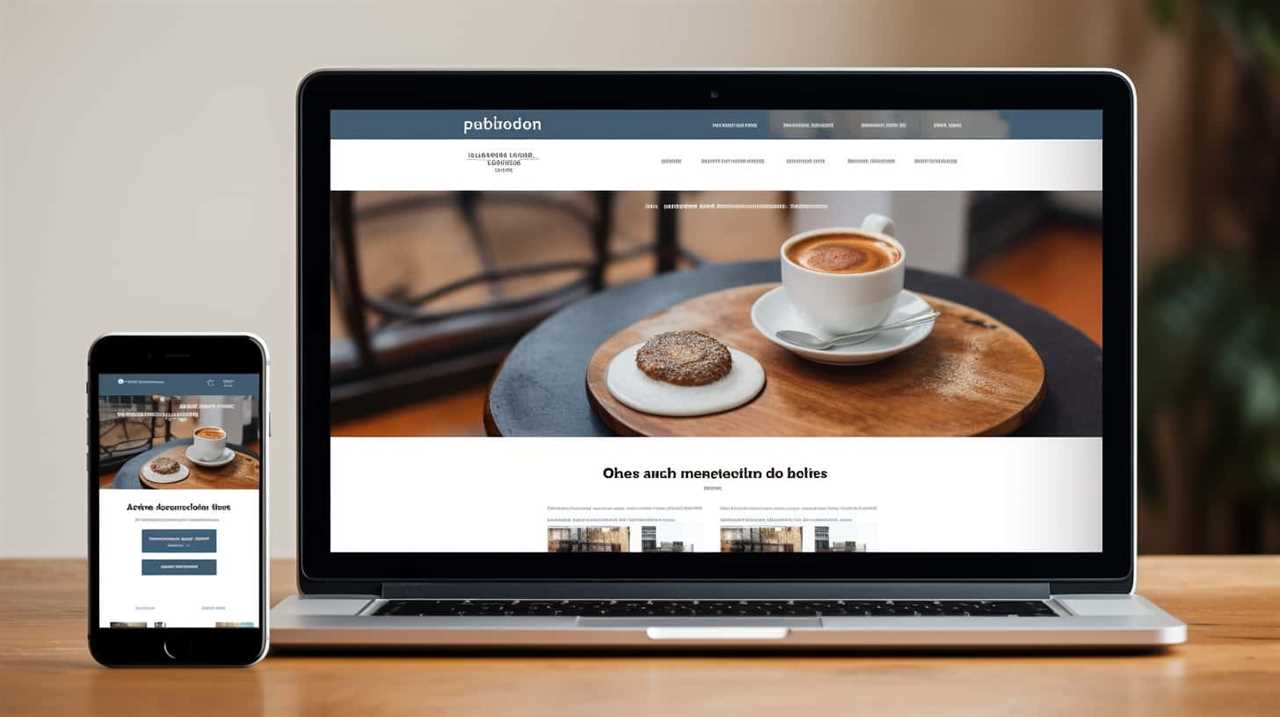As the proprietor of an art center, I understand the challenges involved in connecting with the appropriate online audience. This is the reason I chose to employ Google Ads for the digital promotion of my community art center.
With targeted ads and compelling ad copy, I was able to attract more visitors and boost engagement.
In this article, I’ll share my strategies, from choosing the right keywords to measuring success and ROI.
Get ready to take your art center to the next level with Google Ads.

Key Takeaways
- Online advertising through platforms like Google Ads is essential for community art centers to reach a wider audience and effectively promote their programs.
- Utilizing the targeting options provided by Google Ads allows community art centers to tailor their advertisements and ensure they are seen by interested individuals.
- Google Ads’ robust analytics tools provide valuable data and insights that can be used to track and measure key metrics, enhancing online advertising efforts.
- Creating compelling ad copy that uses artistic language, targets relevant audiences, includes effective call-to-action strategies, and showcases visuals of the art center’s artwork is crucial for engaging and converting potential visitors.
The Importance of Online Advertising
Online advertising is essential for community art centers to reach a wider audience and promote their programs effectively. The benefits of online advertising for community art centers are manifold.
Firstly, it allows them to target specific demographics and interests, ensuring that their message reaches the right people. By utilizing platforms like Google Ads, art centers can create highly targeted campaigns that engage with potential visitors who are most likely to be interested in their programs. This not only increases the chances of attracting new visitors but also maximizes the return on investment.
Secondly, online advertising provides art centers with valuable data and insights. With the help of analytics tools, they can track and measure the performance of their campaigns in real-time. This data-driven approach allows art centers to make informed decisions, optimize their advertising strategies, and allocate resources more effectively. By understanding what resonates with their online audiences, art centers can create compelling content that drives engagement and encourages participation.
To effectively reach and engage with online audiences, art centers should focus on creating visually appealing and interactive ads. Incorporating captivating visuals and compelling calls-to-action can capture the attention of potential visitors and encourage them to explore further. Additionally, leveraging social media platforms and collaborating with influencers in the art community can help extend the reach of art center’s online advertising efforts.

Understanding Google Ads
Exploring the capabilities of Google Ads can greatly enhance a community art center’s online advertising efforts. Understanding ad targeting is crucial for maximizing the effectiveness of Google Ads. Ad targeting allows you to reach the right audience at the right time, ensuring that your ads are seen by people who are most likely to be interested in your community art center.
Google Ads provides various targeting options, such as demographics, interests, and location. By understanding your target audience, you can create ads that resonate with their specific interests and needs. For example, if your art center offers classes for children, you can target parents in the local area who’ve shown an interest in art education.
Measuring ad effectiveness is equally important in understanding the impact of your advertising campaigns. Google Ads provides robust analytics tools that allow you to track and measure key metrics, such as impressions, clicks, and conversions. By analyzing these metrics, you can gain insights into the performance of your ads and make data-driven decisions to optimize your campaigns.
Targeting the Right Audience
To effectively reach the desired audience, I utilize Google Ads’ targeting options to tailor my community art center’s online advertisements. By understanding audience segmentation and employing ad targeting techniques, I can ensure that our ads are seen by the right people at the right time.

Here is a breakdown of the different audience segments we target and the corresponding ad targeting techniques we employ:
| Audience Segment | Ad Targeting Technique |
|---|---|
| Local residents | Geolocation targeting |
| Art enthusiasts | Interest targeting |
| Parents | Demographic targeting |
| Students | Age targeting |
| Event attendees | Remarketing |
By segmenting our audience and using these ad targeting techniques, we can maximize the effectiveness of our online advertisements. For example, by targeting local residents, we can increase foot traffic to our art center. By targeting art enthusiasts, we can attract individuals who are more likely to engage with our art programs and events. And by targeting parents and students, we can promote our classes and workshops specifically tailored for them.
Creating Compelling Ad Copy
When it comes to creating compelling ad copy, it’s crucial to use artistic language that captivates and engages the audience.
By targeting relevant audiences, we can tailor our messaging to resonate with their interests and preferences.

Additionally, incorporating effective call-to-action strategies can drive conversions and encourage potential customers to take the desired action.
Artistic Language for Ads
I can create compelling ad copy for community art centers using artistic language. To draw in and keep the audience interested, I’ll utilize the following techniques:
- Artistic Visuals: By using captivating and visually appealing images, we can grab the attention of potential visitors. Our ads will showcase the vibrant colors, intricate details, and unique perspectives found in the artwork displayed at the community art center.
- Creative Messaging: We’ll craft ad copy that sparks curiosity and emotion. By using evocative language and storytelling techniques, we can connect with the audience on a deeper level. Our messages will highlight the transformative power of art, inviting people to immerse themselves in a world of creativity and self-expression.
- Data-Driven Approach: We’ll analyze the performance of our ads to optimize their effectiveness. By monitoring click-through rates, conversion rates, and engagement metrics, we can continuously refine our ad copy to maximize results.
With these strategies, we can communicate the captivating experience of community art centers and entice the audience to explore further.
Now, let’s dive into targeting relevant audiences and reaching those who’ll truly appreciate what these art centers have to offer.

Targeting Relevant Audiences
Building upon the strategies discussed earlier, I can now delve into targeting relevant audiences and creating compelling ad copy for community art centers.
Audience segmentation is crucial in ensuring that your ads reach the right people at the right time. By identifying the specific demographics, interests, and behaviors of your target audience, you can tailor your ad copy to resonate with them on a personal level.
Additionally, geo targeting strategies allow you to focus your ads on specific locations where your target audience is most likely to be found. This ensures that you’re maximizing your ad spend and reaching the people who are most likely to engage with your community art center.
Call-To-Action Strategies
To effectively engage with your target audience, it’s important to employ call-to-action strategies that create compelling ad copy for community art centers. Here are three effective strategies to consider:

- Use clear and concise language: Make your call-to-action straightforward and easy to understand. Use action verbs and concise phrases that clearly communicate what you want the audience to do.
- Create a sense of urgency: Encourage immediate action by incorporating time-limited offers or limited availability. Phrases like ‘limited time only’ or ‘book now before spots fill up’ can create a sense of urgency and prompt the audience to act quickly.
- Test and measure conversion rates: Continuously monitor the effectiveness of your call-to-action strategies by measuring conversion rates. Analyze data to determine which strategies are driving the most conversions and adjust your ad copy accordingly.
Choosing the Right Keywords
When it comes to Google Ads for community art centers, choosing the right keywords is crucial.
By identifying the target audience and selecting relevant keywords, we can maximize the visibility of our ads and ensure they’re seen by the right people.
This data-driven approach allows us to optimize our advertising efforts and increase the chances of attracting potential visitors to our art center.
Target Audience and Keywords
As a digital marketer, I focus on selecting the most relevant keywords to reach the target audience for community art centers through Google Ads.

To effectively target the right audience and maximize the impact of our ads, I employ the following strategies:
- Target Audience Segmentation: Understanding the diverse interests and demographics of potential art center visitors is crucial. By segmenting the target audience based on factors such as age, location, and artistic preferences, we can create tailored ads that resonate with different groups.
- Keyword Research Strategies: Thorough keyword research is essential for optimizing ad performance. I analyze popular search terms related to community art centers, such as ‘art classes,’ ‘local galleries,’ and ‘art events,’ to identify the most relevant and high-converting keywords for our ads.
- Data-Driven Approach: By leveraging data analytics tools, I continuously monitor the performance of our ads and adjust our keyword strategy accordingly. This data-driven approach ensures that we’re constantly optimizing our ads to reach the right audience and drive meaningful engagement with community art centers.
Maximizing Ad Visibility
In order to maximize ad visibility for community art centers, I rely on a data-driven approach to choose the right keywords. By analyzing search trends and conducting thorough keyword research, I can identify the most relevant and high-performing keywords that will improve ad targeting and increase click-through rates.
To ensure optimal results, I focus on long-tail keywords that are specific to the community art center’s offerings and target audience. These keywords not only attract users who are actively searching for art-related activities but also help narrow down the competition, increasing the chances of ad visibility.
Moreover, I constantly monitor and analyze the performance of the chosen keywords. This allows me to make data-backed adjustments and optimizations, ensuring that the ads are reaching the right audience at the right time.

Optimizing Landing Pages for Conversions
To optimize landing pages for conversions, I focus on utilizing compelling content and strategic design. By following these key strategies, I can increase user engagement and drive conversions:
- Simplify the design: A clean and intuitive landing page design is crucial for a positive user experience. I ensure that the layout is easy to navigate, with clear call-to-action buttons and minimal distractions. This helps users focus on the desired action, whether it’s signing up for a newsletter or making a purchase.
- Craft compelling content: The content on the landing page should be concise, persuasive, and tailored to the target audience. I use persuasive language, highlighting the unique selling points of the community art center and emphasizing the benefits of engaging with their programs and events.
- Optimize for mobile: With the majority of internet users accessing websites through mobile devices, it’s essential to optimize landing pages for mobile users. I make sure that the landing page design is responsive and loads quickly on mobile devices, providing a seamless experience for users on the go.
Setting up Conversion Tracking
I will set up conversion tracking by configuring the necessary settings and implementing the tracking code provided by Google Ads. Setting up conversion tracking is crucial for community art centers to effectively measure the return on investment (ROI) from their Google Ads campaigns. By tracking conversions, you can gain valuable insights into the effectiveness of your advertising efforts and make data-driven decisions to optimize your campaigns.
To get started, log in to your Google Ads account and navigate to the ‘Tools & Settings’ menu. From there, select ‘Conversions’ and click on the blue plus button to create a new conversion action. Choose the appropriate conversion type based on your goals, such as website purchases or form submissions.
Next, you’ll need to configure the settings for your conversion action. Define the conversion value, which allows you to assign a monetary value to each conversion. This is particularly useful for tracking the ROI of your advertising campaigns. You can also set up additional parameters, such as the conversion window and attribution model, to ensure accurate tracking.

Once you have configured the settings, Google Ads will provide you with a tracking code snippet. This code should be implemented on the relevant pages of your website to track conversions accurately. Make sure to place the code on the conversion confirmation page to capture successful actions.
Monitoring Ad Performance
To effectively monitor the performance of Google Ads campaigns for community art centers, it’s essential for me to analyze key metrics and make data-driven adjustments. Here are three important ways I measure ad engagement and track ad impressions:
- Click-through Rate (CTR): CTR measures the percentage of people who click on your ad after seeing it. A high CTR indicates that your ad is relevant and compelling, while a low CTR may suggest the need for ad optimization.
- Conversion Rate: Conversion rate measures the percentage of people who take a desired action, such as signing up for a newsletter or purchasing a ticket, after clicking on your ad. By tracking conversion rate, I can evaluate the effectiveness of my ads in driving actions that support the community art center.
- Ad Impression Share: Ad impression share indicates the percentage of times your ad is shown compared to the total number of times it was eligible to be shown. A low ad impression share may suggest that your budget or targeting needs adjustment.
A/B Testing for Success
How can A/B testing contribute to the success of Google Ads campaigns for community art centers? A/B testing techniques are essential for measuring campaign effectiveness and optimizing ad performance. By conducting A/B tests, community art centers can gather valuable data on which ads and strategies are resonating with their target audience.
A/B testing involves creating two or more versions of an ad and testing them against each other to see which one performs better. This can be done by changing elements such as ad copy, images, headlines, or call-to-action buttons. By comparing the performance of these different versions, community art centers can identify the most effective combination of elements to drive higher click-through rates, conversions, and ultimately, success.

Measuring campaign effectiveness through A/B testing allows community art centers to make data-driven decisions. By analyzing the results, they can uncover insights about their audience’s preferences and behaviors, and refine their ads accordingly. This iterative process of testing and optimizing ensures that their Google Ads campaigns are continuously improving and delivering the best possible results.
Budgeting and Bidding Strategies
When it comes to budgeting and bidding strategies for Google Ads, the goal is to maximize your ad spend to get the best results.
By targeting the right audience, you can ensure that your ads are shown to people who are most likely to be interested in your community art center.
Additionally, optimizing your bid strategies can help you achieve a higher ad position while still staying within your budget.

Maximize Ad Spend
I maximize my ad spend for our community art center by implementing effective budgeting and bidding strategies. Here are three key tactics I use to ensure the best ROI for our Google Ads campaign:
- Set a realistic budget: I carefully analyze our financial resources and allocate a reasonable budget for our ad campaign. This helps me avoid overspending while still reaching a wide audience.
- Optimize bids based on data: I regularly monitor the performance of our ads and adjust our bidding strategy accordingly. By analyzing click-through rates, conversion rates, and other metrics, I can identify underperforming ads and reallocate our budget to the most effective ones.
- Utilize ad scheduling: I strategically schedule our ads to appear during peak times when our target audience is most likely to engage. This ensures that our ad spend is focused on reaching the right people at the right time.
Targeting the Right Audience
To effectively target the right audience and optimize our Google Ads campaign, I rely on precise audience segmentation and strategic bidding strategies. By segmenting our audience based on demographics, interests, and behaviors, we can create tailored ads that resonate with specific groups.
Additionally, implementing geo-targeting strategies allows us to reach potential customers in specific locations, maximizing our campaign’s impact and budget.
One effective way to segment our audience is by age group. By understanding the demographics of our target audience, we can create ads that speak directly to their interests and preferences. For example, younger audiences may be more interested in contemporary art classes, while older audiences may prefer traditional painting workshops.

Another important aspect of audience segmentation is considering their interests and behaviors. By analyzing data and insights from Google Analytics, we can identify the interests and behaviors of our potential customers. This allows us to create targeted ads that match their interests, increasing the chances of conversion.
Geo-targeting strategies play a crucial role in reaching the right audience. By narrowing down our ads to specific locations, we can ensure that our ads are seen by potential customers in our community. For instance, if our art center is located in a specific neighborhood, we can target our ads to that area to maximize our reach and increase the chances of attracting local visitors.
To further optimize our Google Ads campaign, strategic bidding strategies are essential. By setting realistic budgets and strategically bidding on relevant keywords, we can ensure that our ads are shown to the right audience at the right time. This allows us to maximize our ad spend and achieve better results.
Optimizing Bid Strategies
Implementing strategic bidding strategies is crucial for optimizing the budget and bidding process in our Google Ads campaign for community art centers. To ensure the best results, we need to focus on optimizing ad placements and utilizing effective bid management techniques. Here are three key factors to consider:

- Targeted Ad Placements: By identifying websites and platforms that are relevant to our target audience, we can increase the chances of our ads being seen by the right people. This helps maximize the impact of our budget and improve the overall performance of our campaign.
- Bid Adjustments: Utilizing bid adjustments based on factors such as location, device, and time of day can help us reach our target audience more effectively. By adjusting our bids accordingly, we can ensure that our ads are shown in the most relevant contexts, increasing the likelihood of conversions.
- Monitoring Performance Metrics: Regularly monitoring key performance metrics such as click-through rates, conversion rates, and cost per conversion allows us to make data-driven decisions. By analyzing these metrics, we can identify areas of improvement and optimize our bid strategies for better results.
Remarketing to Previous Visitors
With Google Ads, I can effectively target and engage previous visitors to our community art center. Remarketing strategies are a powerful tool that allows us to reconnect with individuals who’ve already shown interest in our center. By using remarketing lists, we can create tailored ads that specifically target these previous visitors, increasing the chances of conversion.
Conversion rate optimization is a key aspect of remarketing. By analyzing data from previous visits, we can gain insights into user behavior and preferences. This data-driven approach allows us to create more personalized and relevant ads, increasing the likelihood of converting previous visitors into paying customers.
Through remarketing, we can remind previous visitors about upcoming events, special promotions, or new exhibits. By staying top of mind, we increase the chances of these individuals returning to our community art center and engaging with our offerings.
Moreover, remarketing can also help us reach individuals who may have abandoned their cart or expressed interest but didn’t complete a purchase. By strategically targeting these individuals with tailored ads and incentives, we can encourage them to come back and complete the conversion.

Leveraging Ad Extensions
By leveraging ad extensions, I can enhance the effectiveness of our Google Ads campaigns for our community art center, connecting with potential visitors in more engaging and interactive ways.
Here are three ways I can make the most out of ad extensions:
- Site link extensions: By including additional links to specific pages on our website, such as our upcoming events or gallery, we can provide easy access to relevant information. This allows users to quickly find what they’re looking for and increases the chances of them converting into visitors.
- Call extensions: By adding a phone number to our ads, potential visitors can easily reach out to us for inquiries or to make reservations. This adds a personal touch and makes it convenient for them to engage with our art center.
- Location extensions: By displaying our art center’s address alongside our ads, we can attract local visitors who may be searching for nearby cultural attractions. This helps increase foot traffic and encourages people to explore our community art center.
By effectively using ad extensions, we can create more compelling ads that grab the attention of potential visitors.
Now, let’s delve into the next section and explore how we can measure the success and ROI of our Google Ads campaigns.

Measuring Success and ROI
To gauge the effectiveness of our Google Ads campaigns for our community art center, I’ll assess the success and return on investment (ROI) by analyzing key metrics and tracking conversions. Measuring ad effectiveness is crucial to understanding how well our campaigns are performing and whether they’re generating the desired results.
One of the key metrics we’ll focus on is click-through rate (CTR), which measures the percentage of people who click on our ads after seeing them. A high CTR indicates that our ads are compelling and engaging to our target audience.
Another important metric is conversion rate, which measures the percentage of people who take a desired action, such as signing up for a class or purchasing artwork, after clicking on our ads. This metric directly reflects the effectiveness of our campaigns in driving meaningful actions.
Tracking campaign performance is essential to optimizing our Google Ads strategy. By analyzing data such as impressions, clicks, and conversions, we can identify trends and make data-driven decisions to improve our campaigns.

Ultimately, measuring success and ROI allows us to allocate our resources effectively, ensuring that we’re investing in the most impactful campaigns and driving tangible results for our community art center.
Frequently Asked Questions
How Can Community Art Centers Effectively Utilize Social Media Platforms to Enhance Their Online Advertising Efforts?
Social media platforms and community art centers are a match made in creative heaven. By maximizing the impact of social media advertising, art centers can effectively enhance their online advertising efforts and reach a wider audience.
What Are Some Common Mistakes That Community Art Centers Make When Using Google Ads, and How Can They Be Avoided?
When using Google Ads for community art centers, it’s important to avoid common mistakes like targeting errors and poor ad design. By carefully selecting the right audience and creating visually appealing ads, success can be achieved.
Are There Any Specific Features or Tools Within Google Ads That Are Particularly Beneficial for Community Art Centers?
There are specific features and tools within Google Ads that are particularly beneficial for community art centers. These include targeting options, ad extensions, and conversion tracking, which can help optimize campaigns and reach the right audience effectively.

How Can Community Art Centers Ensure That Their Ad Copy Is Engaging and Compelling Enough to Capture the Attention of Their Target Audience?
Crafting captivating messages is the art of persuasion. To engage and capture attention, community art centers can ensure their ad copy is compelling by creating inspiring and action-driven content that resonates with their target audience.
What Are Some Best Practices for Community Art Centers to Track and Measure the Success of Their Online Advertising Campaigns in Terms of Return on Investment (Roi)?
Measuring ROI and tracking the success of online advertising campaigns are essential for community art centers. It allows us to determine the effectiveness of our efforts and make data-driven decisions for future campaigns.
Conclusion
In conclusion, using Google Ads for community art centers is like painting a vibrant digital picture that captures the attention of the right audience. By understanding the importance of online advertising and implementing strategies such as targeting the right audience, creating compelling ad copy, and leveraging ad extensions, art centers can effectively reach their goals.
Just like a masterful painting, measuring success and ROI allows for continuous improvement and growth. Embrace the power of Google Ads to bring your art center to life in the digital realm.











